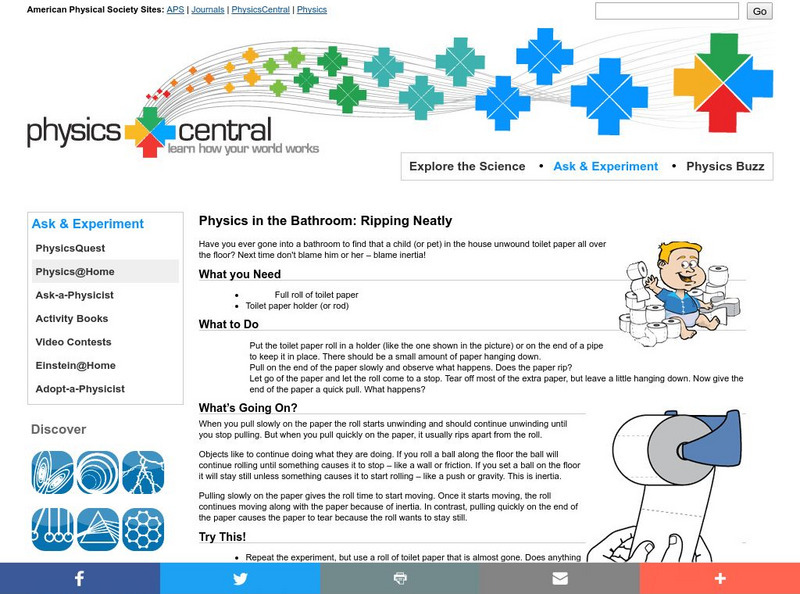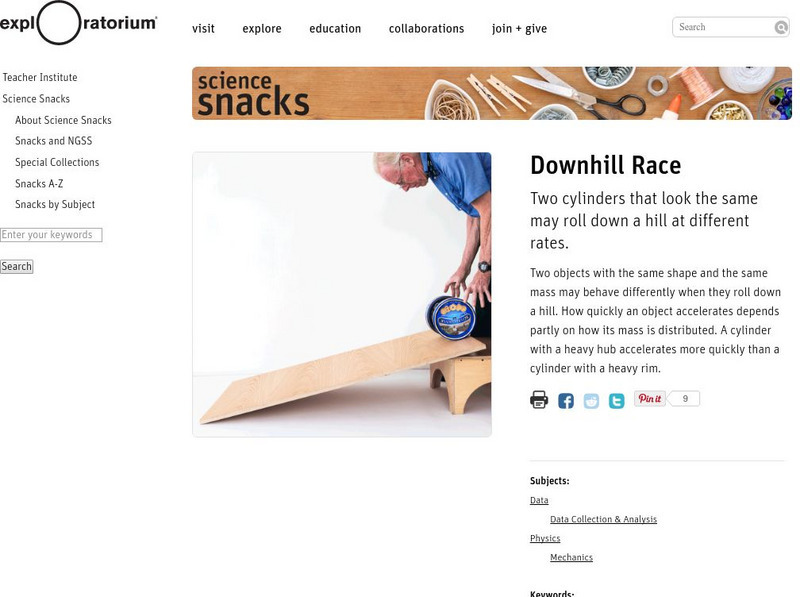PBS
Pbs Learning Media: Newton's Triple Play: Baseball Science
In this lesson, students watch a video and animations that relate Isaac Newton's three laws of motion to baseball and apply what they've learned about these laws to another sport or other real-life situation.
Other
Bscs: Forces and Motion Content Background Document
In this document, we will try to answer a fundamental question of physical science, "Why do things start to move, slow down, speed up, stop moving or change direction?" In answering these core questions we can develop concepts that can...
Physics Central
Physics Central: Physics in the Bathroom: Ripping Neatly
A great science experiment to demonstrate Newton's First Law of Motion, inertia. There is a step-by-step guide on how to conduct this experiment and links to other sites about inertia.
Curated OER
Zona Land: Galileo and Inertia
A tutorial with accompanying animations on classical mechanics. Well-illustrated. Good navigation.
University of Utah
University of Utah: Dept. Of Mathematics: Physics of Skiing
Do you like to ski? If you do, do you ski for the physical sport of it? This resource turns the attention to the mathematical side of the winter sport.
Pennsylvania State University
Kettering University: The Simple Harmonic Oscillator
The motion of three simple harmonic oscillators is animated to illustrate the effects of mass and spring constant upon the motion. Several equations and a lengthy discussion accompany the animations.
University of Guelph
University of Guelph: Physics Tutorials: Torque and Angular Acceleration
Words and equations are used to explain the relationship between angular acceleration and the torque exerted upon an object. Well-written; great graphics.
University of Guelph
University of Guelph: Physics Tutorials: Moment of Inertia
This site has a list of moments of inertia for various objects.
Science and Mathematics Initiative for Learning Enhancement (SMILE)
Smile: The Soup Roll
A lab activity written for grade 5. Students roll various cans down inclined planes and compare the times required to reach the bottom. Results are related to rotational inertia.
Science Education Resource Center at Carleton College
Serc: Trucking and Thinking Newton's First Law of Motion
For this activity students simulate the movement of cargo in the bed of a truck in order to experience Newton's first law of motion.
Science Education Resource Center at Carleton College
Serc: Newton's Second: Having a Ball With Motion
Students will create a gravity ball launcher to demonstrate their understanding of mass, force, momentum, and motion. The students will use critical thinking, measurement, and observation and analysis of data to make changes and improve...
Science Education Resource Center at Carleton College
Serc: Investigating Inertia
In this investigation, young scholars will perform a simple ordering activity and demonstration to determine what inertia is and recognize how inertia affects objects. They will compare and contrast the masses of objects to predict the...
Open Curriculum
Open Curriculum: Velocity and Relative Motion
An illustrated article helps physics students learn about center of mass and velocity, and define the concept of inertia.
Exploratorium
Exploratorium: Bicycle Wheel Gyro
Description of a museum exhibit in which the spinning bicycle wheel induces the rotation of a student in a rotating chair. Excellent demonstration idea.
Exploratorium
Exploratorium: Gyroscope
Description of a museum exhibit in which the forces exerted by two gyroscope wheels are analyzed. Excellent demonstration idea.
Other
Fear of Physics: Ball on a String
See Newton's First Law of Motion in action. View a movie that illustrates this principle of physics.
Other
Easy Science for Kids: All About Force: Pushing and Pulling
Students will understand that pushes and pulls can have different strengths and directions. Students investigate the effects of these different pushes and pulls.
Other
Wikibooks: Physics Study Guide
A handy resource that gives an overview of equations and definitions pertinent to an introductory, college-level physics course, with two of its three sections focusing on motion-related topics and principles.
Scholastic
Scholastic: Study Jams! Science: Our Solar System: Gravity & Inertia
A video and a short multiple-choice quiz on the topic of gravity and inertia, and how they work together to keep objects from floating off into space.
Center of Science and Industry
Cosi Columbus: Catapult
Science experiment that demonstrates how energy is transferred. Includes full list of materials, procedures, and scientific explanation of how the tension in the catapult causes an object to travel far.
Scholastic
Scholastic: Study Jams! Science: Force and Motion: Newton's First Law: Inertia
A video and a short multiple-choice quiz on the meaning of inertia.
Scholastic
Scholastic: Study Jams! Science: Forces and Motion: Acceleration
A video and a short quiz on acceleration.
Sophia Learning
Sophia: Newton's First Law: Lesson 3
This lesson introduces Newton's First Law, that inertia causes objects at rest to remain at rest, and objects in motion to remain in motion. It is 3 of 3 in the series titled "Newton's First Law."
Exploratorium
Exploratorium: Science Snacks: Downhill Race
An activity that explores how two cylinders that are identical in shape and mass may travel down a hill differently due to how their mass is distributed. Learn how the distribution of mass in an object can affect its translational...

















